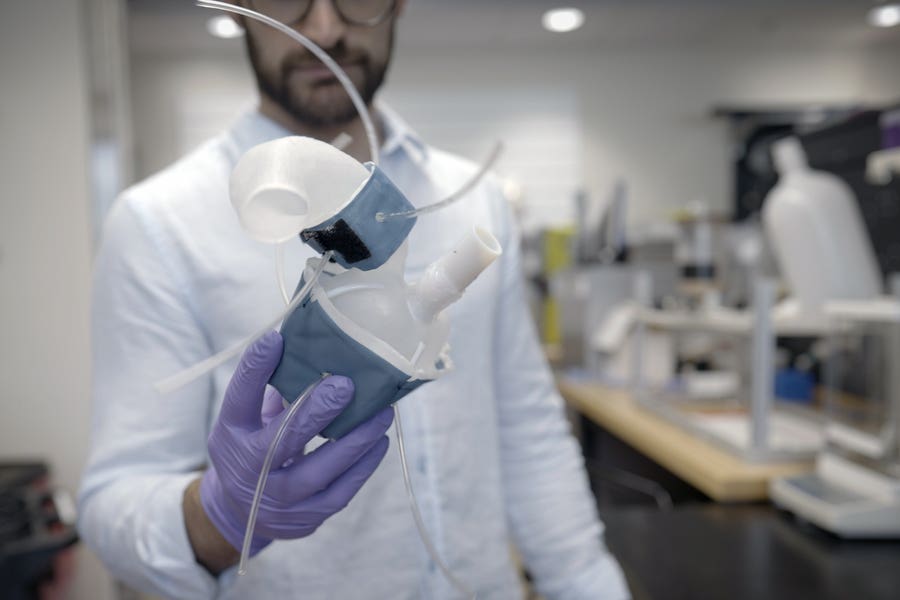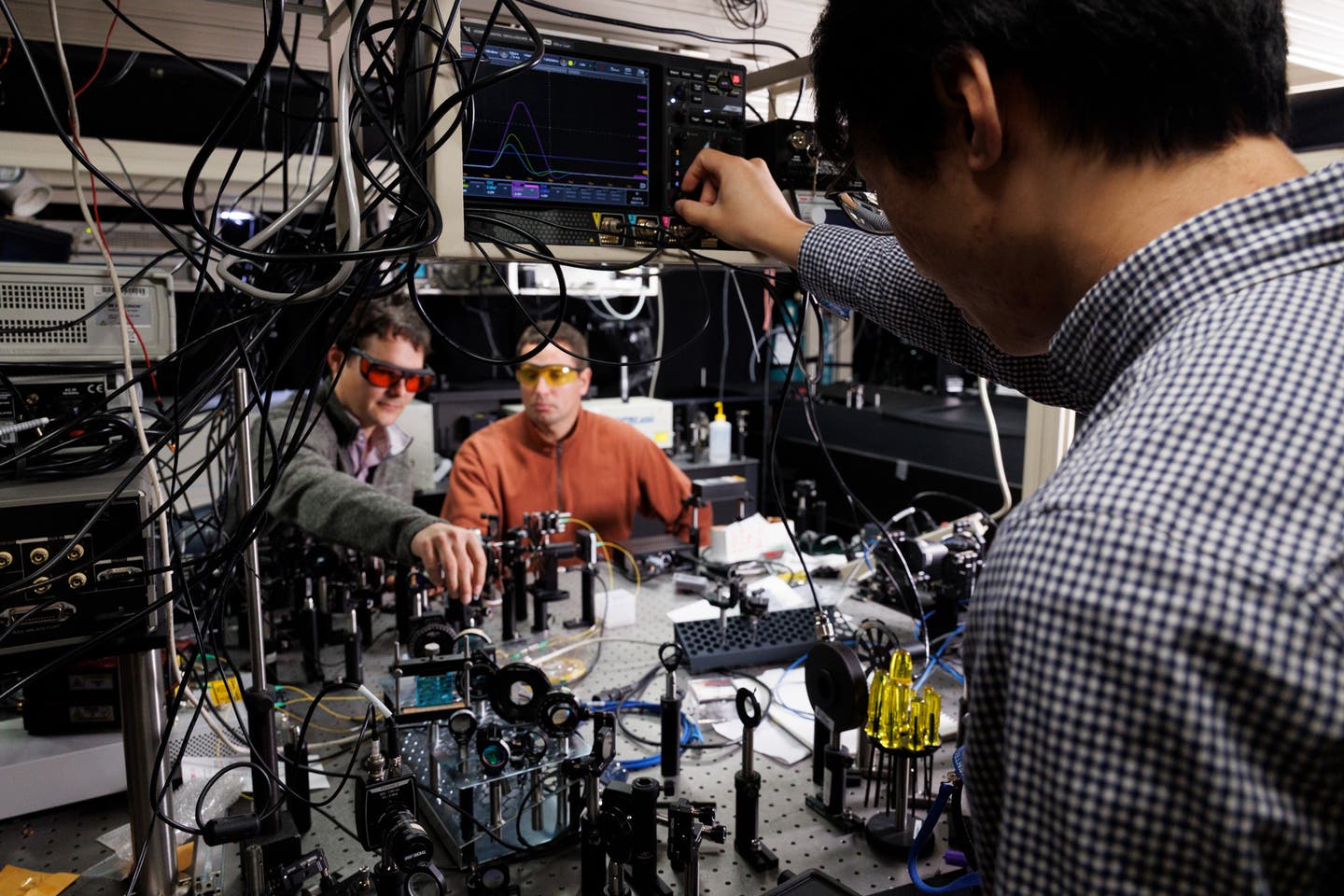Scientists create 3D-printed hearts that look and pump just like the real thing
Heart shapes and sizes differ from one individual to another, a variance that becomes more pronounced in those living with heart diseases.

[Oct. 2, 2023: Staff Writer, The Brighter Side of News]
MIT engineers are hoping to help doctors tailor treatments to patients’ specific heart form and function, with a custom robotic heart. The team has developed a procedure to 3D print a soft and flexible replica of a patient’s heart. (CREDIT: Melanie Gonick, MIT)
In the world of medical science, it's long been understood that no two hearts beat alike. Heart shapes and sizes differ from one individual to another, a variance that becomes more pronounced in those living with heart diseases. Their hearts and major vessels are overburdened, striving hard to compensate for compromised functionality.
Recent developments at MIT offer hope of reshaping heart disease treatment by creating patient-specific heart replicas. These tailored models aim to bring about a new era of personalized cardiovascular interventions.
Creating a Heart's Twin
MIT engineers have established a process to 3D print a soft and flexible replica of a patient's heart, enhancing the ability to mimic its blood-pumping capability. This innovation could drastically revolutionize how treatments are approached, especially in patients with complicated heart conditions.
Related Stories
The development process kicks off by transforming medical images of a patient’s heart into a 3D computer model. With the help of a polymer-based ink, these models are brought to life through 3D printing, culminating in a soft, flexible shell, identical in shape to the patient's heart.
Beyond just the heart, the technology extends to the printing of a patient's aorta, the pivotal artery responsible for blood flow from the heart to other body parts.
Mimicking the Rhythms of Life
Emulating the heart's natural rhythm posed a challenge. The solution? Sleeves reminiscent of blood pressure cuffs. These, when wrapped around the 3D-printed heart and aorta, employ the physics of bubble wrap patterns to recreate the pumping action of the heart. Connected to a pneumatic system, these sleeves expand and contract the heart model in a rhythmic cadence, replicating the actual heart's beating mechanism.
Furthermore, researchers have achieved success in simulating aortic stenosis, a condition where the aortic valve narrows, increasing the heart's workload. This is accomplished by inflating a separate sleeve around the printed aorta, allowing them to emulate the vessel's constriction.
The most compelling potential of this research lies in its application. In treating aortic stenosis, doctors often surgically introduce synthetic valves to widen the aorta’s natural valve. Looking ahead, medical professionals could use these 3D-printed models to trial various valve designs, selecting the optimal fit and function tailored to individual patients.
The action of the soft, robotic models can be controlled to mimic the patient’s blood-pumping ability. (CREDIT: Melanie Gonick, MIT)
Furthermore, these heart replicas present invaluable platforms for research labs and the medical device sector, enabling realistic testing avenues for heart disease therapies.
“All hearts are different,” shares Luca Rosalia, an MIT-Harvard Program graduate student. "There are vast differences, especially among ailing patients. Our system's edge lies in its ability to replicate not just a heart’s structure but its functionality across health and disease."
The Backstory: Perseverance Amidst Pandemic
Rosalia, alongside a team of distinguished colleagues, unveiled their findings in a recent edition of Science Robotics.
The structure of the biorobotic hybrid heart under magnetic resonance imaging. (CREDIT: Christopher T. Nguyen)
The inception of this innovation traces back to January 2020 when the team, under the leadership of mechanical engineering professor Ellen Roche, pioneered a “biorobotic hybrid heart.” This creation, a generalized heart replica, utilized synthetic muscles with inflatable cylinders to emulate the contractions of an actual heart.
However, the Covid-19 pandemic imposed setbacks, shutting down lab operations. Rosalia, showcasing unwavering commitment, adapted by recreating the entire heart-pumping system from the confines of his dormitory.
Upon reopening, the team resumed their endeavors, enhancing the control mechanism of the heart-pumping sleeve, employing both animal and computational models. The venture into individualized patient models demanded the precision of 3D printing.
Motion of the biorobotic hybrid heart mimics the pumping motion of the heart under echocardiography. (CREDIT: Mossab Saeed)
“There's a surging interest in the medical domain towards 3D printing to replicate patient anatomy accurately. This is pivotal for pre-procedure planning and training,” observes Wang, a vascular surgery resident.
A Peek into the Future
In their study, the team showcased the prowess of 3D printing to produce replicas of 15 patients diagnosed with aortic stenosis. These models, when printed, could emulate the characteristics of a beating heart.
A notable triumph came when the team managed to replicate post-surgical outcomes in the printed aortas after implanting synthetic valves, producing flows analogous to actual patients post-surgery.
Roche and team envisage a future where clinicians utilize these models for pre-operative planning. “Patients would undergo imaging, and we’d employ that to develop this system, potentially within a day,” mentions co-author Nyugen. This opens doors to trials with diverse valve types, determining the ideal fit before actual surgery.
In essence, these patient-specific models could pave the way for treatments that cater to individuals with unique cardiac structures.
“Designing for a wide range of anatomies and testing interventions across this spectrum could amplify the potential patients for minimally invasive procedures,” Roche enthuses.
This groundbreaking research received support from esteemed institutions including the National Science Foundation, the National Institutes of Health, and the National Heart Lung Blood Institute.
Note: Materials provided above by The Brighter Side of News. Content may be edited for style and length.
Like these kind of feel good stories? Get the Brighter Side of News' newsletter.



